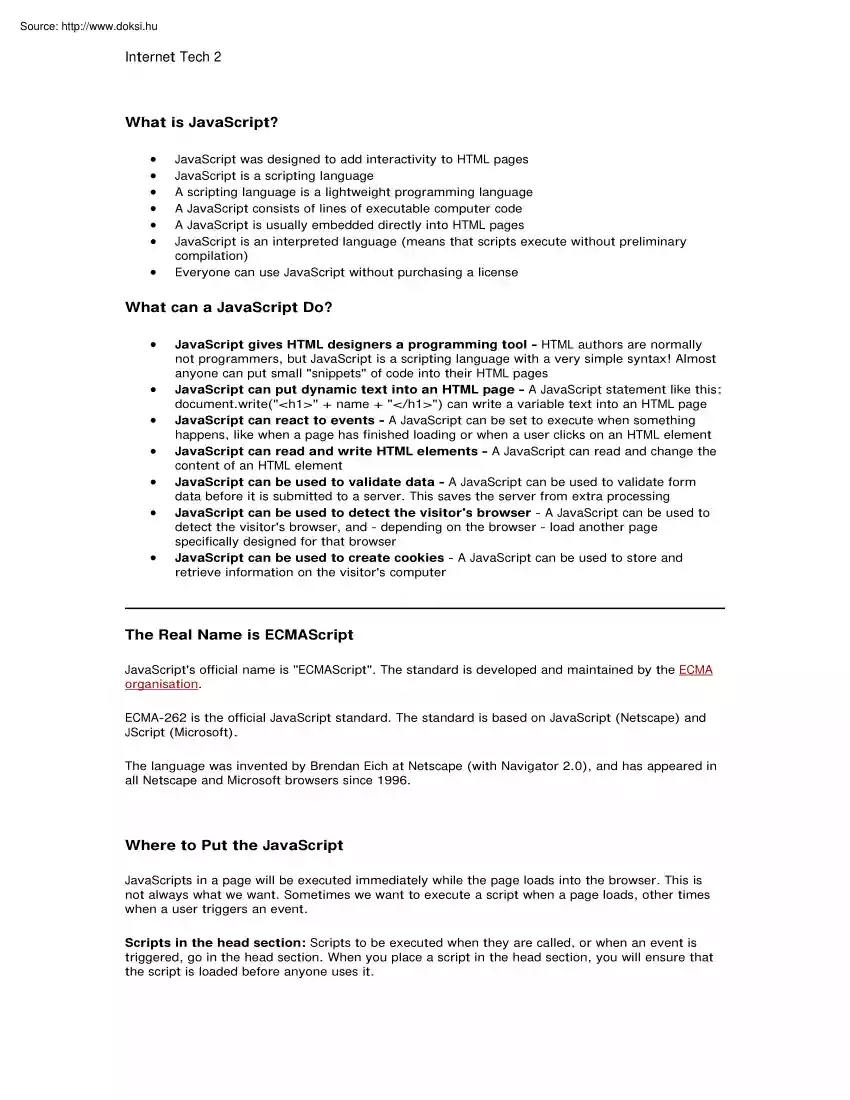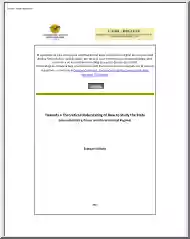A doksi online olvasásához kérlek jelentkezz be!

A doksi online olvasásához kérlek jelentkezz be!
Nincs még értékelés. Legyél Te az első!
Mit olvastak a többiek, ha ezzel végeztek?
Tartalmi kivonat
Internet Tech 2 What is JavaScript? • • • • • • • JavaScript was designed to add interactivity to HTML pages JavaScript is a scripting language A scripting language is a lightweight programming language A JavaScript consists of lines of executable computer code A JavaScript is usually embedded directly into HTML pages JavaScript is an interpreted language (means that scripts execute without preliminary compilation) Everyone can use JavaScript without purchasing a license What can a JavaScript Do? • • • • • • • JavaScript gives HTML designers a programming tool - HTML authors are normally not programmers, but JavaScript is a scripting language with a very simple syntax! Almost anyone can put small "snippets" of code into their HTML pages JavaScript can put dynamic text into an HTML page - A JavaScript statement like this: document.write("<h1>" + name + "</h1>") can write a variable text into an HTML page
JavaScript can react to events - A JavaScript can be set to execute when something happens, like when a page has finished loading or when a user clicks on an HTML element JavaScript can read and write HTML elements - A JavaScript can read and change the content of an HTML element JavaScript can be used to validate data - A JavaScript can be used to validate form data before it is submitted to a server. This saves the server from extra processing JavaScript can be used to detect the visitor's browser - A JavaScript can be used to detect the visitor's browser, and - depending on the browser - load another page specifically designed for that browser JavaScript can be used to create cookies - A JavaScript can be used to store and retrieve information on the visitor's computer The Real Name is ECMAScript JavaScript's official name is "ECMAScript". The standard is developed and maintained by the ECMA organisation. ECMA-262 is the official JavaScript standard.
The standard is based on JavaScript (Netscape) and JScript (Microsoft). The language was invented by Brendan Eich at Netscape (with Navigator 2.0), and has appeared in all Netscape and Microsoft browsers since 1996. Where to Put the JavaScript JavaScripts in a page will be executed immediately while the page loads into the browser. This is not always what we want. Sometimes we want to execute a script when a page loads, other times when a user triggers an event. Scripts in the head section: Scripts to be executed when they are called, or when an event is triggered, go in the head section. When you place a script in the head section, you will ensure that the script is loaded before anyone uses it. Internet Tech 2 <html> <head> <script type="text/javascript"> . </script> </head> Scripts in the body section: Scripts to be executed when the page loads go in the body section. When you place a script in the body section it generates the content
of the page. <html> <head> </head> <body> <script type="text/javascript"> . </script> </body> Scripts in both the body and the head section: You can place an unlimited number of scripts in your document, so you can have scripts in both the body and the head section. <html> <head> <script type="text/javascript"> . </script> </head> <body> <script type="text/javascript"> . </script> </body> Using an External JavaScript Sometimes you might want to run the same JavaScript on several pages, without having to write the same script on every page. To simplify this, you can write a JavaScript in an external file. Save the external JavaScript file with a .js file extension Note: The external script cannot contain the <script> tag! To use the external script, point to the .js file in the "src" attribute of the <script> tag: <html>
<head> <script src="xxx.js"></script> </head> <body> </body> </html> Internet Tech 2 Note: Remember to place the script exactly where you normally would write the script! JavaScript Events New to HTML 4.0 was the ability to let HTML events trigger actions in the browser, like starting a JavaScript when a user clicks on an HTML element. New to HTML 4.0 was the ability to let HTML events trigger actions in the browser, like starting a JavaScript when a user clicks on an HTML element. Below is a list of the attributes that can be inserted into HTML tags to define event actions. FF: Firefox, N: Netscape, IE: Internet Explorer Attribute The event occurs when. FF N IE onabort Loading of an image is interrupted 1 3 4 onblur An element loses focus 1 2 3 onchange The user changes the content of a field 1 2 3 onclick Mouse clicks an object 1 2 3 ondblclick Mouse double-clicks an object 1 4 4 onerror An error
occurs when loading a document or an image 1 3 4 onfocus An element gets focus 1 2 3 onkeydown A keyboard key is pressed 1 4 3 onkeypress A keyboard key is pressed or held down 1 4 3 onkeyup A keyboard key is released 1 4 3 onload A page or an image is finished loading 1 2 3 onmousedown A mouse button is pressed 1 4 4 onmousemove The mouse is moved 1 6 3 onmouseout The mouse is moved off an element 1 4 4 onmouseover The mouse is moved over an element 1 2 3 onmouseup A mouse button is released 1 4 4 onreset The reset button is clicked 1 3 4 onresize A window or frame is resized 1 4 4 onselect Text is selected 1 2 3 onsubmit The submit button is clicked 1 2 3 onunload The user exits the page HTML DOM Objects In addition to the built-in JavaScript objects, you can also access and manipulate all of the HTML DOM objects with JavaScript. The HTML DOM defines a standard set of objects for HTML, and a standard way to
access and manipulate HTML documents. JavaScript Objects Internet Tech 2 Follow the links to learn more about the objects and their collections, properties, methods and events. Contain lots of examples! Object Description Window The top level object in the JavaScript hierarchy. The Window object represents a browser window. A Window object is created automatically with every instance of a <body> or <frameset> tag Navigator Contains information about the client's browser Screen Contains information about the client's display screen History Contains the visited URLs in the browser window Location Contains information about the current URL HTML DOM Objects Follow the links to learn more about the objects and their collections, properties, methods and events. Contain lots of examples! Object Description Document Represents the entire HTML document and can be used to access all elements in a page Anchor Represents an <a> element Area
Represents an <area> element inside an image-map Base Represents a <base> element Body Represents the <body> element Button Represents a <button> element Event Represents the state of an event Form Represents a <form> element Frame Represents a <frame> element Frameset Represents a <frameset> element Iframe Represents an <iframe> element Image Represents an <img> element Input button Represents a button in an HTML form Input checkbox Represents a checkbox in an HTML form Input file Represents a fileupload in an HTML form Input hidden Represents a hidden field in an HTML form Input password Represents a password field in an HTML form Input radio Represents a radio button in an HTML form Input reset Represents a reset button in an HTML form Input submit Represents a submit button in an HTML form Input text Represents a text-input field in an HTML form Link Represents a <link> element Meta
Represents a <meta> element Option Represents an <option> element Select Represents a selection list in an HTML form Style Represents an individual style statement Table Represents a <table> element Internet Tech 2 TableData Represents a <td> element TableRow Represents a <tr> element Textarea Represents a <textarea> element JavaScript Variables As with algebra, JavaScript variables are used to hold values or expressions. A variable can have a short name, like x, or a more describing name like length. A JavaScript variable can also hold a text value like in carname="Volvo". Rules for JavaScript variable names: • • Variable names are case sensitive (y and Y are two different variables) Variable names must begin with a letter or the underscore character NOTE: Because JavaScript is case-sensitive, variable names are case-sensitive. Declaring (Creating) JavaScript Variables Creating variables in JavaScript is most
often referred to as "declaring" variables. You can declare JavaScript variables with the var statement: var x; var carname; Assigning Values to Undeclared JavaScript Variables If you assign values to variables that has not yet been declared, the variables will automatically be declared. These statements: x=5; carname="Volvo"; have the same effect as: var x=5; var carname="Volvo";
JavaScript can react to events - A JavaScript can be set to execute when something happens, like when a page has finished loading or when a user clicks on an HTML element JavaScript can read and write HTML elements - A JavaScript can read and change the content of an HTML element JavaScript can be used to validate data - A JavaScript can be used to validate form data before it is submitted to a server. This saves the server from extra processing JavaScript can be used to detect the visitor's browser - A JavaScript can be used to detect the visitor's browser, and - depending on the browser - load another page specifically designed for that browser JavaScript can be used to create cookies - A JavaScript can be used to store and retrieve information on the visitor's computer The Real Name is ECMAScript JavaScript's official name is "ECMAScript". The standard is developed and maintained by the ECMA organisation. ECMA-262 is the official JavaScript standard.
The standard is based on JavaScript (Netscape) and JScript (Microsoft). The language was invented by Brendan Eich at Netscape (with Navigator 2.0), and has appeared in all Netscape and Microsoft browsers since 1996. Where to Put the JavaScript JavaScripts in a page will be executed immediately while the page loads into the browser. This is not always what we want. Sometimes we want to execute a script when a page loads, other times when a user triggers an event. Scripts in the head section: Scripts to be executed when they are called, or when an event is triggered, go in the head section. When you place a script in the head section, you will ensure that the script is loaded before anyone uses it. Internet Tech 2 <html> <head> <script type="text/javascript"> . </script> </head> Scripts in the body section: Scripts to be executed when the page loads go in the body section. When you place a script in the body section it generates the content
of the page. <html> <head> </head> <body> <script type="text/javascript"> . </script> </body> Scripts in both the body and the head section: You can place an unlimited number of scripts in your document, so you can have scripts in both the body and the head section. <html> <head> <script type="text/javascript"> . </script> </head> <body> <script type="text/javascript"> . </script> </body> Using an External JavaScript Sometimes you might want to run the same JavaScript on several pages, without having to write the same script on every page. To simplify this, you can write a JavaScript in an external file. Save the external JavaScript file with a .js file extension Note: The external script cannot contain the <script> tag! To use the external script, point to the .js file in the "src" attribute of the <script> tag: <html>
<head> <script src="xxx.js"></script> </head> <body> </body> </html> Internet Tech 2 Note: Remember to place the script exactly where you normally would write the script! JavaScript Events New to HTML 4.0 was the ability to let HTML events trigger actions in the browser, like starting a JavaScript when a user clicks on an HTML element. New to HTML 4.0 was the ability to let HTML events trigger actions in the browser, like starting a JavaScript when a user clicks on an HTML element. Below is a list of the attributes that can be inserted into HTML tags to define event actions. FF: Firefox, N: Netscape, IE: Internet Explorer Attribute The event occurs when. FF N IE onabort Loading of an image is interrupted 1 3 4 onblur An element loses focus 1 2 3 onchange The user changes the content of a field 1 2 3 onclick Mouse clicks an object 1 2 3 ondblclick Mouse double-clicks an object 1 4 4 onerror An error
occurs when loading a document or an image 1 3 4 onfocus An element gets focus 1 2 3 onkeydown A keyboard key is pressed 1 4 3 onkeypress A keyboard key is pressed or held down 1 4 3 onkeyup A keyboard key is released 1 4 3 onload A page or an image is finished loading 1 2 3 onmousedown A mouse button is pressed 1 4 4 onmousemove The mouse is moved 1 6 3 onmouseout The mouse is moved off an element 1 4 4 onmouseover The mouse is moved over an element 1 2 3 onmouseup A mouse button is released 1 4 4 onreset The reset button is clicked 1 3 4 onresize A window or frame is resized 1 4 4 onselect Text is selected 1 2 3 onsubmit The submit button is clicked 1 2 3 onunload The user exits the page HTML DOM Objects In addition to the built-in JavaScript objects, you can also access and manipulate all of the HTML DOM objects with JavaScript. The HTML DOM defines a standard set of objects for HTML, and a standard way to
access and manipulate HTML documents. JavaScript Objects Internet Tech 2 Follow the links to learn more about the objects and their collections, properties, methods and events. Contain lots of examples! Object Description Window The top level object in the JavaScript hierarchy. The Window object represents a browser window. A Window object is created automatically with every instance of a <body> or <frameset> tag Navigator Contains information about the client's browser Screen Contains information about the client's display screen History Contains the visited URLs in the browser window Location Contains information about the current URL HTML DOM Objects Follow the links to learn more about the objects and their collections, properties, methods and events. Contain lots of examples! Object Description Document Represents the entire HTML document and can be used to access all elements in a page Anchor Represents an <a> element Area
Represents an <area> element inside an image-map Base Represents a <base> element Body Represents the <body> element Button Represents a <button> element Event Represents the state of an event Form Represents a <form> element Frame Represents a <frame> element Frameset Represents a <frameset> element Iframe Represents an <iframe> element Image Represents an <img> element Input button Represents a button in an HTML form Input checkbox Represents a checkbox in an HTML form Input file Represents a fileupload in an HTML form Input hidden Represents a hidden field in an HTML form Input password Represents a password field in an HTML form Input radio Represents a radio button in an HTML form Input reset Represents a reset button in an HTML form Input submit Represents a submit button in an HTML form Input text Represents a text-input field in an HTML form Link Represents a <link> element Meta
Represents a <meta> element Option Represents an <option> element Select Represents a selection list in an HTML form Style Represents an individual style statement Table Represents a <table> element Internet Tech 2 TableData Represents a <td> element TableRow Represents a <tr> element Textarea Represents a <textarea> element JavaScript Variables As with algebra, JavaScript variables are used to hold values or expressions. A variable can have a short name, like x, or a more describing name like length. A JavaScript variable can also hold a text value like in carname="Volvo". Rules for JavaScript variable names: • • Variable names are case sensitive (y and Y are two different variables) Variable names must begin with a letter or the underscore character NOTE: Because JavaScript is case-sensitive, variable names are case-sensitive. Declaring (Creating) JavaScript Variables Creating variables in JavaScript is most
often referred to as "declaring" variables. You can declare JavaScript variables with the var statement: var x; var carname; Assigning Values to Undeclared JavaScript Variables If you assign values to variables that has not yet been declared, the variables will automatically be declared. These statements: x=5; carname="Volvo"; have the same effect as: var x=5; var carname="Volvo";



